Figures & data
TABLE 1 PM10 & PM2.5 mean particulate filter dataFootnote a of 4 feedyards (FY)
FIG. 1 PM10 and PM2.5 dust composite over days 1, 2, and 3 were analyzed by the Elzone method for mass and the geometric mean size are presented for FY1, FY2, and FY3 at the upwind and downwind positions. Note: The Elzone information for PM2.5 from FY2 is missing due to insufficient amount of dust collected on the filters.
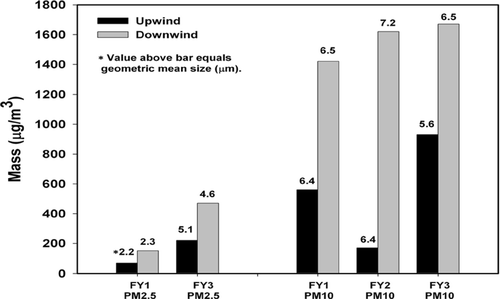
FIG. 2 PM10 and PM2.5 dust composite over days 1, 2, and 3 were analyzed by the Elzone method for population (count) and the geometric mean size are presented for FY1, FY2, and FY3 at the upwind and downwind positions. Note: see .
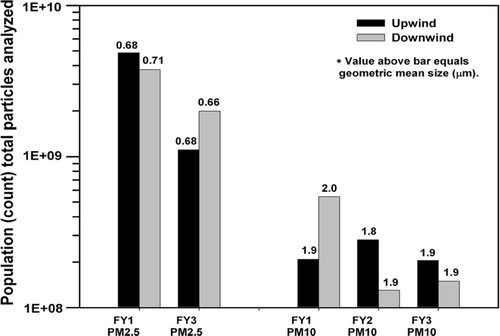
FIG. 3 Part A, is the Elzone (Coulter method) analysis of the feedyard particulates collected on filters by RAAS 300 PM2.5 monitors in the summer, upwind and downwind of feedyard 1 and feedyard 3. Twenty-four hour filters for day 1, 2, and 3 were pooled in order to have adequate dust for the analysis. Data are presented in equal distant percentiles by quantity in μg/m3 ofair and mean size (μm in diameter). Part B, is the Elzone (Coulter method) analysis of the feedyard particulate collected on filters by RAAS 300 PM10 monitors in the summer, upwind and downwind of feedyards 1, 2 and 3. Filters for day 1, 2, and 3 (are matched on the same days as Part A) were pooled in order to have adequate dust for the analysis. Data are presented in equal distant percentiles by quantity in μg/m3 of air and mean size (pm in diameter).
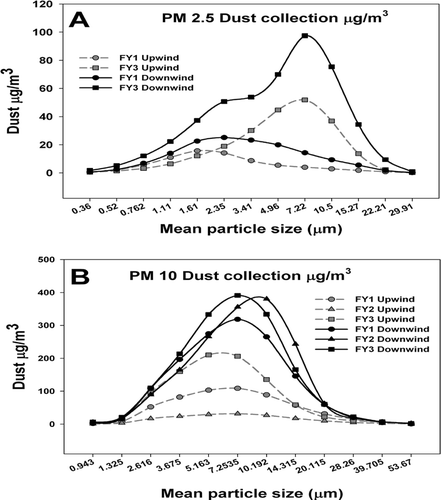
FIG. 4 Feedyard PM10 Elzone analysis of parti culates on filters (day 1, 2, and 3 combined), percent of total particles and mean particle size by channel (0.77 sigma intervals) from upwind and downwind of three feedyards (FY1, FY2, and FY3).
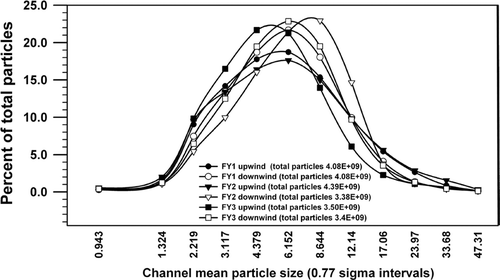
FIG. 5 Feedyard PM2.5 Elzone analysis of particulate on filters (days 1, 2, and 3 combined), mean (standard deviation [SD]) of total particles, and size data by percentiles (0,77 sigma intervals) from upwind and downwind of two feedyards.
![FIG. 5 Feedyard PM2.5 Elzone analysis of particulate on filters (days 1, 2, and 3 combined), mean (standard deviation [SD]) of total particles, and size data by percentiles (0,77 sigma intervals) from upwind and downwind of two feedyards.](/cms/asset/61a09b2a-2399-4142-b1a5-6ed5a73e0296/uast_a_222503_o_f0005g.gif)
FIG. 6 Scanning electron microscope graphic scan plot of a downwind PM2.5 is filter from FY2. The particle is rich in Si and Al and appears to be a clay particle; note the amorphous shape.
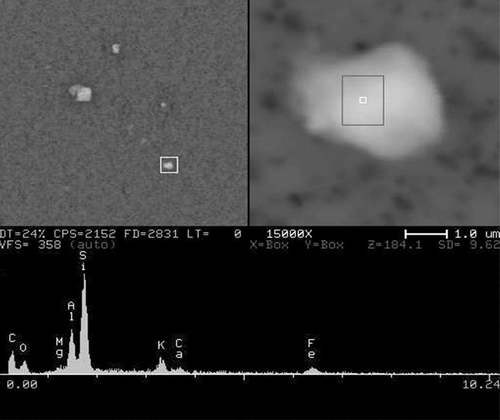
TABLE 2 Scanning electron microscopy analysis of feedyards (FY) dust
FIG. 7 Laser strategic aerosol monitor (SAM) data from four feedyards depicts channel mean total dust concentration ng/m3 ± standard error of mean (SEM) of air (9 channels) for each hour of the day which indicates a sharp rise in dust concentration at 1800 h, maximum at 2100 h, and a sharp decline at 2200 h.

FIG. 8 The general linear model (GLM) two-way interaction for the feedyard mean dust concentration (μg/m3) and mean particle size (μm in diameter) using laser strategic aerosol monitor (SAM) data.
